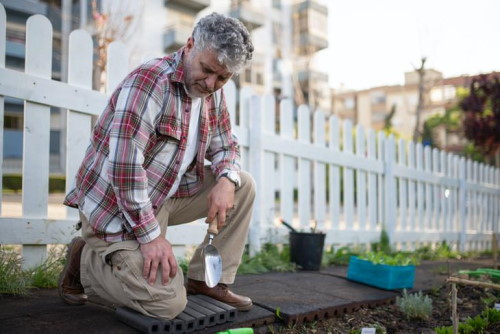- Researchers say older adults who are active throughout the day may be healthier than people who do regularly scheduled exercise are.
- They say one reason is that many people who do structured exercise don’t get enough other movement the rest of the day.
- Experts say it’s OK to start with a small amount of daily activities and then build up the routine as you get used to it.
- They say there are many ways to increase movement during the day, including bringing in groceries one bag at a time and using a second-story bathroom instead of one on a ground level.
BREAKING: Eat This - Never Forget A Single Thing Again
A note for older adults who are looking to stay fit:
A new study says that even daily gym visits don’t have the positive impact that day-long regular movement does.
In fact, the study authors say, people who do choose a regular gym activity as their only workout may be less fit than people who are on the move during the day.
“The biggest challenge we see is the tendency to do what we call ‘substitution,’” said Jason Fanning, PhD, a professor in the department of health and exercise science at Wake Forest University in North Carolina and the lead author of the study.
Substitution, Dr. Fanning told Healthline, is when a person does a regular gym activity — be it a class or a workout — and then compensates in a negative direction, feeling they’ve already succeeded in their daily workout and weight-management goals.
“When (a short period of) vigorous activity replaces the regular, things like walking the dog and other activities,” Fanning said, it can lead to a regaining of weight as well as a loss of muscle mass.
What the study revealed
The study followed older adults who were actively losing weight.
Once they did lose weight, the researchers found that people who participated in multiple short-time activities that kept them moving regularly through the day were less apt to regain weight.
People who participated in “structured” exercise such a gym classes didn’t fare as well, not because those classes are not healthy, but rather because the older adults tended to only do them.
A person loses muscle with weight, Fanning said, and when people regain it shortly after the loss that muscle often does not return, leaving older adults less healthy than they may have been before the weight loss.
The study, he said, backs up what has been suspected.
“Physical activity is clearly a powerful medicine,” Fanning said. “And by moving all day, we get the dose that is good for us.”
Rethinking exercise
So, what’s the solution?
Fanning and other movement experts say that rethinking what exercise means and adapting your day to include it is a great plan.
“First,” Fanning said, “We need to tone down the idea that if it doesn’t hurt or require a gym membership, it doesn’t help.”
He said older adults as well as other age groups should look at their days and find ways to almost organically add movement.
Step one? Make it fun.
“The key is to find something you enjoy doing and to find a way to integrate it into your day,” Christopher Gagliardi, scientific education content manager at The American Council on Exercise, told Healthline.
Gagliardi said his organization suggests older adults find a way to fit to complete 150 minutes of moderate-intensity aerobic activity per week by identifying activities they enjoy that keep them moving.
Walking with friends, walking a pet, gardening or biking are a few examples.
It’s OK to ease into it
If the idea of 150 minutes per week sounds overwhelming, Gagliardi said, people can start from anywhere and add on as they go.
“Even brief bouts of activity such as climbing a few flights of stairs can lead to health benefits,” he said. The concept of short bouts of physical activity can be thought of in terms of “activity snacking.”
“Just like food snacks eaten throughout the day, activity snacks are small bouts of physical activity that take place throughout the day where a person works to increase their usual level of physical activity to a new level of activity,” Gagliardi said.
Kyle Risley, the CEO of LiftVault, a company that helps people build workout programs that blend into their lives, said starting anywhere is the right move.
“Stretching when they get out of bed in the morning is an excellent place to start,” he said. “This, followed by regularly getting up throughout the day to walk around a room can also prevent many ailments caused by a sedentary lifestyle.”
The goal, Risley told Healthline, is to establish sustainable habits.
Making your day ‘movement-friendly’
Fanning said it’s important that older adults find activities that make them happy and don’t overwhelm them.
First, he said, this does not mean the gym is a bad idea. Social groups can help some people in the gym scene.
Gagliardi suggested these activities as ways to keep moving in an enjoyable way:
- Move every 1 to 2 hours each day. He suggests setting a timer and when it goes off, walk a bit, rake one section of a garden, shoot 10 free throws. Whatever you like. You can set a timer for every hour.
- Dance during television commercials.
- Do push-ups against a wall or with hands on a countertop after each trip to the bathroom.
- Carry in your groceries one bag at a time.
- Walk or ride your bike to visit a neighbor.
- If downstairs, use the upstairs restroom.
- Shadowbox for 5 minutes every hour.
- Practice your golf swing for 10 minutes after reading a chapter in a book.
- Make food to share with a neighbor and walk to deliver it.
- Ride your bike around the block one time at the conclusion of each TV show you watch.
- Make a game out of reading or watching television that incorporates physical activity. (For example: Every time a character in the show laughs, do 10 jumping jacks or every time the main character is eating, stand up and sit back down 5 times).
How to know it’s a fit
Fanning said paying attention to how you feel about activities and how they fit into your day helps set a sustainable long-term plan.
“If in your mind you are dreading (the activity planned), then it’s time to pivot,” he said.
Finding social support, Fanning said, is key to success as well. If you feel alone, find active choices that involve others.
“If it’s not inherently enjoyable,” he said, “it’s not going to stick around.”
That said, the experts agree, gyms are not the enemy.
TRENDING: Doctors Can't Believe She Used This To Erase Her Wrinkles...
Rather, an older adult using a gym needs to recognize that it does not replace the need for more movement through the day.
“There is huge value in people going to a gym or senior center and taking classes or working out,” Kim Evans, a fitness coordinator based out of Michigan, told Healthline.
“There are social aspects to working out as well as the physical workout,” she said. “Some people wouldn’t get any exercise if they couldn’t get in the pool for water aerobics. It’s a fine balance.”









